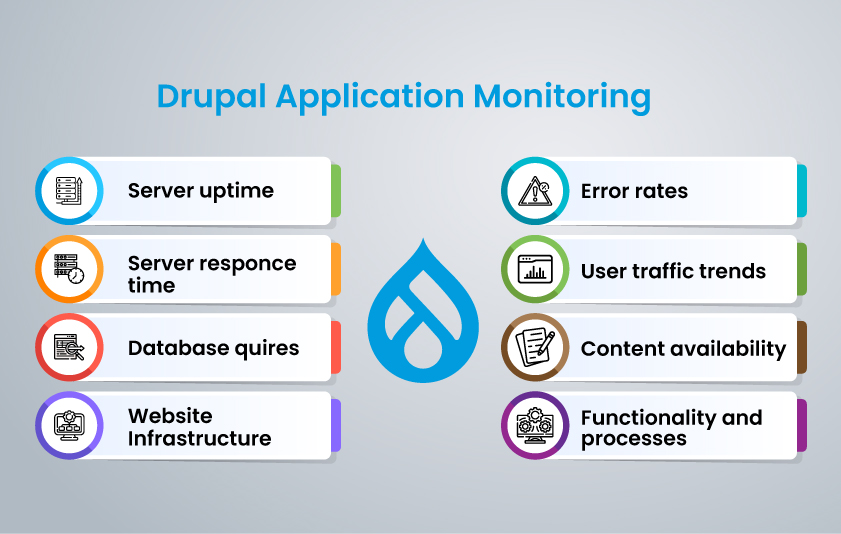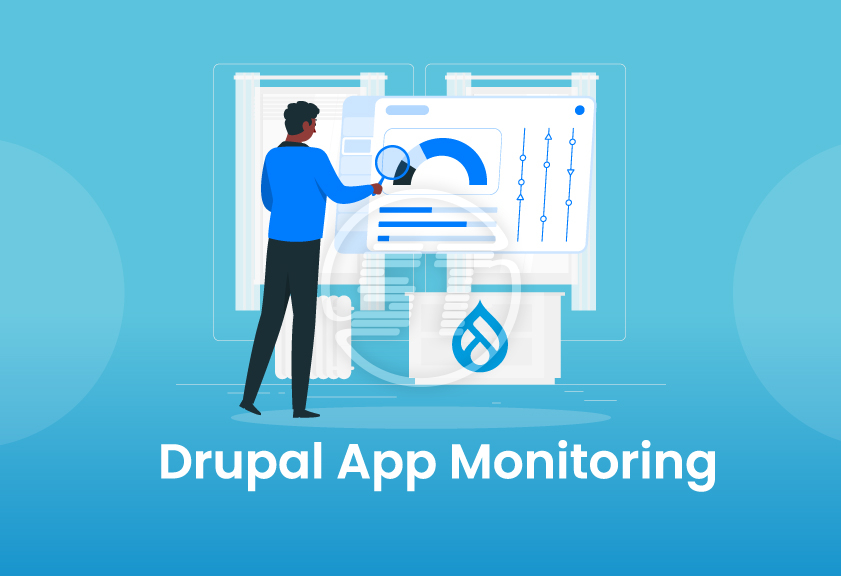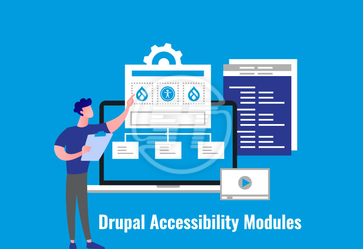Drupal ecosystem is a vast environment; it is more than just content updates and design tweaks. To maintain perfectly running Drupal websites, knowing and understanding application monitoring within the system is important. Application monitoring and retainers help ensure flawless performance and frictionless user experience of a Drupal website/application.
Let’s understand what Drupal application monitoring and its importance is.
Drupal Application monitoring – a boon for website performance!
Drupal Application Monitoring is a process of tracking and analysing different facets of Drupal application / website continuously including server health, application/website performance, infrastructure, content availability, user behavior, etc. It is a way to identify existing and potential bugs, optimize resources, track website uptime, and ensure a properly functioning Drupal website by addressing potential problems proactively.
To monitor Drupal websites/applications, there are dedicated tools that help collect relevant data or the process can be done manually by examining logs in the system. The process of application monitoring is mainly optimizing Drupal website performance and making sure it is available for every visitor and offering them the best possible user experience.
Drupal mainly has two settings to improve platform performance, which is used in application monitoring as well.
Page Cache: Cache mode works for almost all Drupal sites without causing any side effects. This mode makes Drupal websites to skip the loading (init) and unloading (exit) of enabled modules while serving a cached page, resulting in better website performance.
Compressing CSS files: Some of the Drupal modules have their CSS files that add additional HTTP requests to the page and hamper the loading time. Thus, it is asked not to use such modules or at least turn them off it they are not mandatory.
YOU MAY ALSO LIKE: Importance of Drupal Performance Audit
Importance of application monitoring for Drupal websites/applications!
Uninterrupted website/application monitoring is important because,
- It ensures optimal website performance!
- Helps uplift user experience!
- Tightens website security!
- It is a best practice for resource optimization!
- Reduces downtime!
Metrics for application monitoring in order to maintain Drupal website performance!
Application or website monitoring process includes various important metrics that collectively influence overall website health. The metrics provide crucial insight into various facets of web page functionalities. Some of the metrics that require special attention:

Server uptime
It involves server operational duration tracking and measuring to know if it is working without interruptions or not. Servers are responsible for hosting websites and all their services with consistent uptime, allowing users to access them whenever they want to. A healthy server implies a well-performing website, resulting in user satisfaction, improved reliability, and a rise in conversions.
Server response time
It is the time server takes to respond to a request from a user’s browser. The longer the response time, the worse the user experience. Also, page loading time is a crucial ranking factor for search engines, which implies slower response time can be a reason behind poor SEO ranking. Consistent monitoring of server response time and optimization helps in maintaining user experience by providing them with quickly loaded web pages.
Database queries
The requests sent to the database to retrieve information that is needed for a web page are Database Queries. Whenever a user accesses a web page there are multiple queries executed to fetch data like text, images, etc. Either a high query count or slow execution time, they influence the website's overall responsiveness and performance.
Thus, monitoring these queries for your Drupal website includes tracking their frequency, complexity, and execution speed. These metrics assist in optimizing heavy operations by working on data served from the caches ultimately improving the response time. Caching optimization also reduces the strain on the server, enabling it to handle simultaneous requests more effectively.
YOU MAY ALSO LIKE: Importance of Application Maintenance
Website Infrastructure
Likewise, above facets, infrastructure monitoring is equally pivotal for the Drupal website’s outstanding performance. Infrastructure monitoring addresses all the bottlenecks that can be related to technical maintenance or scalability issues. It is the foundation behind a reliable Drupal website and its success in SERPs.
Error rates
Error rates monitoring encompasses each and every issue that a user might encounter while accessing your Drupal website. Errors like 404 errors, server errors, operational glitches, etc. can badly disrupt users’ browsing journey and influence a website’s functionalities as well. Regularly monitoring error rates allows for identifying error patterns and implementation of preventive measures to reduce errors and infuse users' trust on the website.
User traffic trends
Traffic trends include monitoring visitor count, session durations, geographical distribution, page interactions, etc. These metrics provide you insights about audience preferences and surfing patterns, which help you optimize the user journey. This optimization helps you to curate more relevant content to increase engagement and conversions.
Content availability
This monitoring evaluates metrics like accessibility and readiness of the website for every user. It measures the consistent availability of pages, images, and other resources to users. It also includes server uptime and caching mechanisms because downtime and inaccessible content can hamper user interaction and increase bounce rates.
Content availability also impacts SEO and overall outcomes. So, it is important to monitor and optimize content availability to maintain a cutting-edge experience for users.
Functionality and processes
Each functionality of your Drupal website is being reviewed in this type of monitoring. Functionality and process monitoring involves ecommerce transactions, user interactions, forms functionality, menus, links, and execution of every element present on the website. If these critical elements malfunction, it directly hits conversions and eventually revenue.
Monitoring helps find anomalies in functionalities, allowing you to remediate the issue and prevent Drupal website downtime.
YOU MAY ALSO LIKE: Drupal Security Best Practices
Tools that help application monitoring in Drupal!
There are some in-built and third-party application monitoring tools for Drupal that make the whole monitoring process simple.
Drupal’s in-built monitoring capabilities include logging functionality to track and record overall system health metrics along with error occurrences. It records different events in order to provide information about system activities, potential issues, and user interactions. The logged data assists in proactively identifying performance bottlenecks, configuration errors, and other security issues. The features offer actionable data to swiftly detect issues, remediate configuration, and maintain the Drupal website’s health and stability.
Drupal also has a monitoring module to actively monitor websites. There is a real-time dashboard and instant alerts that immediately inform about website performance issues. Drupal Monitor connector helps collect data on metrics like number of users, nodes, page requests, last cron run, etc.
Drupal third-party tools are:
Cacti
network monitoring and graphing tool designed to analyse network performance data.
Zabbix
a comprehensive monitoring tool to track and analyse important facets of network infrastructure and systems’ performance.
Sentry
a modern error-tracking tool to identify issues within the application/website in real time.
Nagios
this tool tracks the health and performance of IT infrastructure.
Google Analytics
tracks user behavior, traffic sources, website engagement, and many other facets of websites.
Wrapping up
Tracking and monitoring the Drupal website is important for its security, user experience, and optimum performance. When you track all essential metrics to ensure their smooth operation, it ultimately fine-tune your Drupal website’s performance. And the boon is that Drupal already has some in-built tools/modules to monitor applications/websites.
Empower your Drupal website with our comprehensive Drupal website / application monitoring and retainer services. As Drupal Gold Certified Partner, we proactively monitor, maintain, and support to elevate your web / mobile application performance, enhance security, and ensure seamless functionality. We also provide ongoing and one-time maintenance and support services to keep your application up to date. For more information contact us at hello@skynettechnologies.com.

